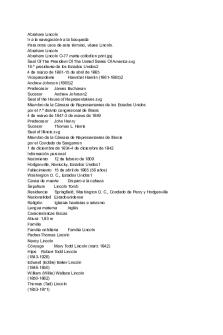History readings - Summary Abraham Lincoln and the Second American Revolution PDF

| Title | History readings - Summary Abraham Lincoln and the Second American Revolution |
|---|---|
| Author | Lilly Grace |
| Course | The United States since 1865 |
| Institution | University of Texas at Austin |
| Pages | 2 |
| File Size | 41.6 KB |
| File Type | |
| Total Downloads | 45 |
| Total Views | 145 |
Summary
Notes of the first two chapters of McPherson's "Abraham Lincoln and the Second American Revolution"...
Description
The Second American Revolution 1. Chapter VII: Liberty and Power in the Second American Revolution Question: How could George Julian believe that military power should remain in the south? How could he advocate the occupation of states by a standing army that gravest of threats to republican liberty? Answer is in the experience of the Civil War & the years of reconstruction after. Experience changed the relationship between liberty and power. The changed relationship between liberty and power The most important point in the issue was slavery. Southerners considered slaves their property and therefore important to their liberty. Rise of the republican party: Was provoked by northern antislavery forces due to the efforts to promote southern liberty by the expansion of slavery. According to Lincoln, the way to purify republicanism, is to restrict the expansion of slavery as the first step to extinction. Southerners believed him and when he was elected, they left the union for that reason. a. They did so in the name of “republican liberty” The core of second American revolution: fundamental transformation in the relationship between liberty and power. According to Lincoln, power was the protector of liberty – excluding liberty that do what they want with the product of another man’s labor. Explaining the difference brought by the civil war in the relationship between power & Liberty. Negative liberty: freedom from interference by ouside authority with individual thought & behavior. a. Vulnerable to power. b. Bill of Rights c. Slaveholders relied on this to guard their right of property in human beings from interference by the national government. d. Example: use of state sovereignty to break up the union – essence of the state of disorder. Positive Liberty: freedom to achieve a status of freedom previously denied by disability or law. a. Form of power. b. Achieved by overwhelming power was the fruition of the second revolution. c. Congress believed that it couldn’t be sustained without the continued and expanded application of national authority. d. Central problem of reconstruction: pg. 138.
Blacks and allies definition of liberty during the revolution: pg. 138. Republicans woke the giant [the guarantee clause in the constitution] to enforce their notion of liberty in postwar south. Southern state governments that were 1/3 of the male citizens were disenfranchised because of race were aristocracies – not republics. 14th and 15th amendments for authority in intervention in state affairs. They accomplished transferred the primary definition and enforcement of citizenship rights from the states to the national government Before 1873 federal courts were backed by US army and became the principle agencied that enforced liberty and equal rights in the south. National power to protect liberty 14th amendment The highest point in development: reached with 3 enforcement acts that expanded jurisdiction of federal courts over civil courts and voting rights and authorized the president the power to suspend habeas corpus and use the army to break up the KKK. 2. Overview: Civil war changed the relationship between power & freedom. Before: freedom = free from tyrannical governments. After: Lincoln showed that power could be essential to freedom by empowering those without power who are without right and freedom. Evolution of the relationship between liberty and power: Protection of liberty from power vs. protection of liberty by power – negative and positive liberty. Bill of rights = negative liberty How the union lost the power to protect the slaves that it freed. Fight over clause in the 14th amendment (which citizenship trumps the other?) Union 1st: national citizenship is superior and the rights of national citizens (everyone) must be respected by the states. Slaughterhouse case reverses the 14th, allowing states to treat citizens the way they wanted. Enabled the Jim Crow. How the union started out awesome, then took several steps backwards to wrong their actions. Slaughterhouse case reverses order of citizenship Conversion of politicians from + liberty to – liberty (showen through Carl). Republicans got tired of fighting for freedmen at the expense of others. ...
Similar Free PDFs

The American Revolution summary
- 5 Pages

Abraham Lincoln - From wikipedia
- 15 Pages

The French and American Revolution
- 10 Pages

Abraham Lincoln essay - Grade: A
- 3 Pages

The Second Shift summary
- 3 Pages

American Revolution quiz
- 2 Pages
Popular Institutions
- Tinajero National High School - Annex
- Politeknik Caltex Riau
- Yokohama City University
- SGT University
- University of Al-Qadisiyah
- Divine Word College of Vigan
- Techniek College Rotterdam
- Universidade de Santiago
- Universiti Teknologi MARA Cawangan Johor Kampus Pasir Gudang
- Poltekkes Kemenkes Yogyakarta
- Baguio City National High School
- Colegio san marcos
- preparatoria uno
- Centro de Bachillerato Tecnológico Industrial y de Servicios No. 107
- Dalian Maritime University
- Quang Trung Secondary School
- Colegio Tecnológico en Informática
- Corporación Regional de Educación Superior
- Grupo CEDVA
- Dar Al Uloom University
- Centro de Estudios Preuniversitarios de la Universidad Nacional de Ingeniería
- 上智大学
- Aakash International School, Nuna Majara
- San Felipe Neri Catholic School
- Kang Chiao International School - New Taipei City
- Misamis Occidental National High School
- Institución Educativa Escuela Normal Juan Ladrilleros
- Kolehiyo ng Pantukan
- Batanes State College
- Instituto Continental
- Sekolah Menengah Kejuruan Kesehatan Kaltara (Tarakan)
- Colegio de La Inmaculada Concepcion - Cebu









